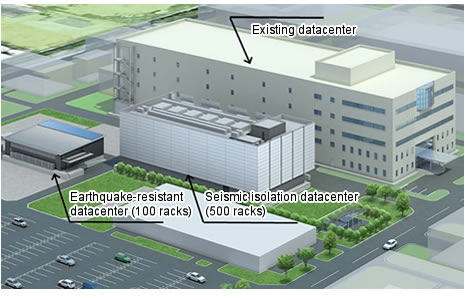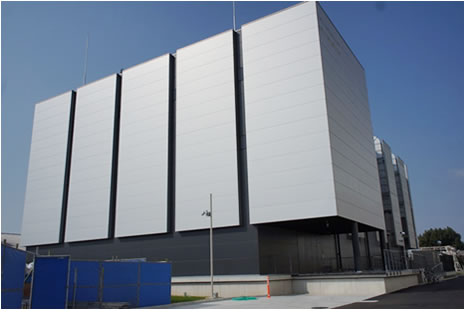Archived content
NOTE: this is an archived page and the content is likely to be out of date.
Fujitsu Opens New Facilities at Akashi System Center, its Main Datacenter in Western Japan
Customers have choice of two different datacenter specifications to suit their needs
Fujitsu Limited
Tokyo, November 21, 2013
Fujitsu today announced that new facilities using modular datacenter technology(1) went into operation today at its Akashi System Center, the company's main datacenter serving western Japan.
As the ways datacenters are used become increasingly varied and complex, such as to enhance business continuity or to use cloud services, Fujitsu has prepared two different types of new datacenters at Akashi System Center:
1. Seismic isolation datacenter: A top-spec center designed for mission-critical systems operations; and
2. Earthquake-resistant datacenter: A standard-spec datacenter offering an ideal balance of cost and quality.
This approach lets customers choose the services best-suited to their particular needs, including within the datacenter facilities.
 Figure: Exterior view of Akashi System Center
Figure: Exterior view of Akashi System Center
 Photo: Seismic isolation datacenter
Photo: Seismic isolation datacenter
As its main datacenters, Fujitsu opened the Tatebayashi System Center in 1995 and the Akashi System Center in 1997. Today Fujitsu operates 68 datacenters throughout Japan for its outsourcing businesses, and has over 40 datacenters outside of Japan that can be linked globally in order to meet the need for customer expansion to worldwide locations.
Following the Great East Japan Earthquake of 2011, as a way of enhancing the business continuity, there is a high need for datacenters to create disaster recovery systems, such as distributed systems and remote backups. At the same time, cloud-based systems are being used to upgrade companies' business systems and even provide uninterrupted operations for mission-critical systems. In these ways, the use of datacenters is becoming increasingly diverse.
In expanding the Akashi System Center, Fujitsu used modular datacenter technology and situated datacenters with different specifications at the same location to be able to meet a variety of datacenter needs. This puts Fujitsu in an even better position to offer outsourcing services optimized to the customer's ICT requirements, including operational management services that build on the company's long track record and cloud services based on advanced technology.
Key Features of the New Facilities at the Akashi System Center
1. Choice of datacenter optimized for different purposes
Akashi is now home to two kinds of datacenters, with plans to gradually expand as needed.
- Seismic isolation datacenter: A top-spec datacenter optimized for mission-critical systems operations.
- Three stories of seismic isolation construction (500 racks), with plans for expansion to 1,000 racks.
- High-efficiency air conditioning takes advantage of outside air.
- Robust physical security includes biometric authentication, tailgating prevention, electrically locked rack systems.
- Long-life emergency generators on site to enhance capacity for handling long-term power interruptions (five times longer than current Fujitsu capacity)
- Earthquake-resistant datacenter: A standard-spec datacenter offering an ideal cost to quality balance.
- One story of earthquake-resistant construction (100 racks × 1, 60 racks × 2), with plans for expansion to 600 racks.
- High-efficiency air conditioning takes advantage of outside air.
- Robust physical security includes biometric authentication, physical locked racks.
- Redundant uninterruptible power supply (UPS) and seismic isolation facilities available as options.
2. Environmentally oriented datacenter with a PUE value(2)of less than 1.2
The new facilities at the Akashi System Center include high-efficiency infrastructure equipment (uninterruptible power supplies, air conditioning) and server room layouts designed using thermodynamic simulations, so they both benefit from past advances in environmental datacenter architecture and also use outside air to reduce air-conditioning power requirements. When supplemental cooling is required in summer months, Fujitsu has developed and deployed new air-conditioning technology (patent pending) that can cool the datacenter throughout the year using outside air, even in warm climates, by combining datacenter cooling equipment with typical packaged air conditioners for server rooms. This technology is unlike typical air-conditioning systems that are individually designed and built. It can easily be deployed regardless of the datacenter's scale or the building's construction, promising to greatly improve the energy efficiency of existing datacenters.
3. Extensive operations-management system
The datacenters are tied into a unified operations-management system that tracks ICT-infrastructure configuration information at Fujitsu's datacenters and at customer sites in and outside of Japan, operational status, incident information, and capacity status. The system can monitor the status of systems around the world throughout the year in real time, 24×7. Furthermore, a Fujitsu service manager will analyze the operational status of a customer's system and, using intelligence accumulated in the datacenter, such as operational improvement models and a database of trouble incidents, support continuous improvements to the quality and value of the customer's ICT resources.
About Fujitsu
Fujitsu is the leading Japanese information and communication technology (ICT) company offering a full range of technology products, solutions and services. Approximately 170,000 Fujitsu people support customers in more than 100 countries. We use our experience and the power of ICT to shape the future of society with our customers. Fujitsu Limited (TSE:6702) reported consolidated revenues of 4.4 trillion yen (US$47 billion) for the fiscal year ended March 31, 2013. For more information, please see http://www.fujitsu.com.
Press Contacts
Public and Investor Relations Division
Inquiries
Company:Fujitsu Limited
All company or product names mentioned herein are trademarks or registered trademarks of their respective owners. Information provided in this press release is accurate at time of publication and is subject to change without advance notice.
Date: 21 November, 2013
City: Tokyo
Company:
Fujitsu Limited,
,
,
,
,
,
,
,
,
,
,
,
,

